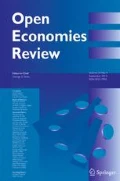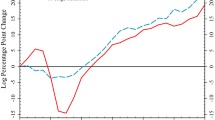Abstract
In this paper, we analyse empirically the determinants of the decision to export, and the export share of manufacturing firms using a large balanced panel database of firms from Spain, spanning from 1990 to 2012. We are particularly interested in investigating these determinants by controlling for state dependence, unobserved heterogeneity and endogenous initial conditions of firms. Our findings reveal that firms show a high persistence in export behaviour, and that export volume changes are determined primarily by changes in the intensive margin. In addition, our research suggests that having exported before, having achieved a certain productivity level and being large and foreign-owned, greatly increased the probability of exporting. Moreover, these results hold even for the export share of firms, except for productivity and foreign capital, which seem to be less relevant.





Similar content being viewed by others
Notes
The percentage of sporadically exporting firms can be obtained adding the exit and entry rate (1.6 and 0.3) calculated for the five year period (see Fig. 4).
Esteve et al. (2009) get higher figures of two years exporting firms, and higher ratios of exit and entry rates into this category, because their firms sample is different from ESEE. They use the export and import directory of firms from the Spanish tax agency (directorio de empresas exportadoras e importadoras de la Agencia Tributaria) which includes firms that necessarily must have exported at least once. Máñez-Castillejo et al. (2008), using the same firms’ survey as we do (ESEE), present almost similar results for two year period exit and entry ratios, although their period of analysis (1990–2000) and the sample of firms (755) are different. Bank of Spain (2011) gets much higher figures for two and five years period entry and exit rates (25 % and 10 % on average respectively), but these figures are not comparable because they use a much broader sample of firms that includes all types of firms, including micro firms that are not present in the ESEE, which supposedly have more volatile export behaviour.
The adaptation consists of how we define a new trade relationship. We consider a new trade relationship in broad terms, as any firm that starts exporting without taking into account new markets or products.
These data are available upon request.
Heckman, J.J., 1981. Heterogeneity and state dependence in S. Rosen (Ed.), Studies in labor markets, 91–140. Chicago: Chicago University Press.
Wooldridge, J.M. (2005), Simple solutions to the initial conditions problem n dynamic, nonlinear panel data models with unobserved heterogeneity, Journal of Applied Econometrics, 20, 39–54.
References
Bank of Spain (2011) The Competitiveness of the Spanish Economy. Annual Report, 37–61
Barba-Navaretti G, Venables AJ (2004) Multinational firms in the world economy. Princeton University Press, New Jersey
Barba-Navaretti G, Bugamelli M, Schivardi F, Altomonte C, Horgos D and Maggioni D (2011) The Global Operations of European Firms. The Second EFIGE Policy Report. Bruegel Blueprint Series, Brussels. http://www.bruegel.org/publications/publication-detail/publication/581-the-global-operations-of-european-firms-the-second-efige-policy-report/
Bernard AB, Jensen JB (2004) Why some firms export? Rev Econ Stat 86(2):561–69
Bernard AB, Jensen JB (2007) Firm structure, multinationals, and manufacturing plant deaths. Rev Econ Stat 89(1):1–11
Bernard AB, Wagner J (2001) Export entry and exit by German firms. Rev World Econ 137:105–23
Besedes T, Prusa TJ (2011) The role of extensive and intensive margins and export growth. J Dev Econ 96(2):371–79
Bugamelli M and Infante L (2003) Sunk Costs of Exports, Temi di Discussione (Economic working papers), Bank of Italy, Economic Research and International Relations Area 469, Bank of Italy, Economic Research and International Relations Area
Campa JM (2004) Exchange rates and trade: How important is hysteresis in trade? Eur Econ Rev 48(3):527–48
Caves RE (1989) Mergers, Takeovers and Economic Efficiency, International Journal of Industrial Organisation, 7
Esteve SV, Pallardo-López VJ, Requena-Silvente F (2009) La dinámica de entrada y salida en mercados Más competitivos. Su impacto en el período 1997–2005. Econ Indus 373:59–72
Fariñas JC, Martin-Marcos A (2007) Exporting and economic performance: firm-level evidence of spanish manufacturing. World Econ 30(4):618–46
Felbermayr GJ, Kohler W (2006) Exploring the intensive and extensive margins of world trade. Rev World Econ 142(4):642–74
Heckman JJ (1981) Heterogeneity and state dependence. In: Rosen S (ed) Studies in labor markets, 91–140. Chicago University Press, Chicago
Helpman E (2011) Understanding global trade. MA, Harvard University Press, Cambridge
Helpman E, Melitz MJ, Yeaple SR (2004) Export versus FDI with heterogeneous firms. Am Econ Rev 94(1):300–16
Ito K, Pucik V (1993) R&D spending, domestic competition, and export performance of Japanese manufacturing firms. Strateg Manag J 14(1):61–75
Kirbach M, Schmiedeberg C (2008) Innovation and export performance: adjustment and remaining differences in east and west German manufacturing. Econ Innov New Technol 17(5):435–57
Krugman P (1980) Scale economies, product differentiation, and the pattern of trade. Am Econ Rev 70(5):950–59
Lawless M (2013) Marginal distance: does export experience reduce firm trade costs? Open Econ Rev 24:819–841
Máñez JA, Rochina-Barrachina ME, Sanchis-Llopis JA (2014) The dynamic linkages among exports. R&D and Produc World Econ. doi:10.1111/twec.12160
Máñez-Castillejo JA, Rochina-Barrachina ME, Sanchis-Llopis JA (2008) Sunk costs hysteresis in spanish manufacturing exports. Rev World Econ 144(2):272–94
Melitz M (2003) The impact of trade on intra-industry reallocations and aggregate industry productivity. Econometrica 71(6):1695–725
Minondo A, Requena F (2012) The intensive and extensive margins of trade: decomposing exports growth differences across spanish regions. Investig Reg 16:53–76
Roberts MJ, Tybout JR (1997) The decision to export in Colombia: an empirical model of entry with sunk costs. Am Econ Rev 87:545–64
Schlegelmilch BB, Crook JN (1988) Firm-level determinants of export intensity. Manag Decis Econ 9(4):291–300
Tadesse, B., White, R. and Shukralla, E. (2015): Production Efficiency and the Extensive Margins of U.S. Exporters: an Industry Level Analysis, Open Economies Review (DOI: 10.1007/s11079-015-9346-z)
Wagner J (2007) Exports and productivity: a survey of the evidence from firm level data. World Econ 30(12):60–82
Wagner, J. (2011): Exports, Imports and Profitability: First Evidence for Manufacturing Enterprises, Open Economies Review (10.1007/s11079-011-9235-z)
Wagner J (2012) International trade and firm performance: a survey of empirical studies since 2006. Rev World Econ 148(2):235–67
Wooldridge JM (2005) Simple solutions to the initial conditions problem in dynamic, nonlinear panel data models with unobserved heterogeneity. J Appl Econ 20(1):39–54
Author information
Authors and Affiliations
Corresponding author
Additional information
We would like to thank the associate editor and two anonymous referees for their helpful comments. The usual disclaimer applies.
Rights and permissions
About this article
Cite this article
Altuzarra, A., Bustillo, R. & Rodríguez, C. Understanding Export Market Success: Evidence from Manufacturing Firms. Open Econ Rev 27, 161–181 (2016). https://doi.org/10.1007/s11079-015-9368-6
Published:
Issue Date:
DOI: https://doi.org/10.1007/s11079-015-9368-6




